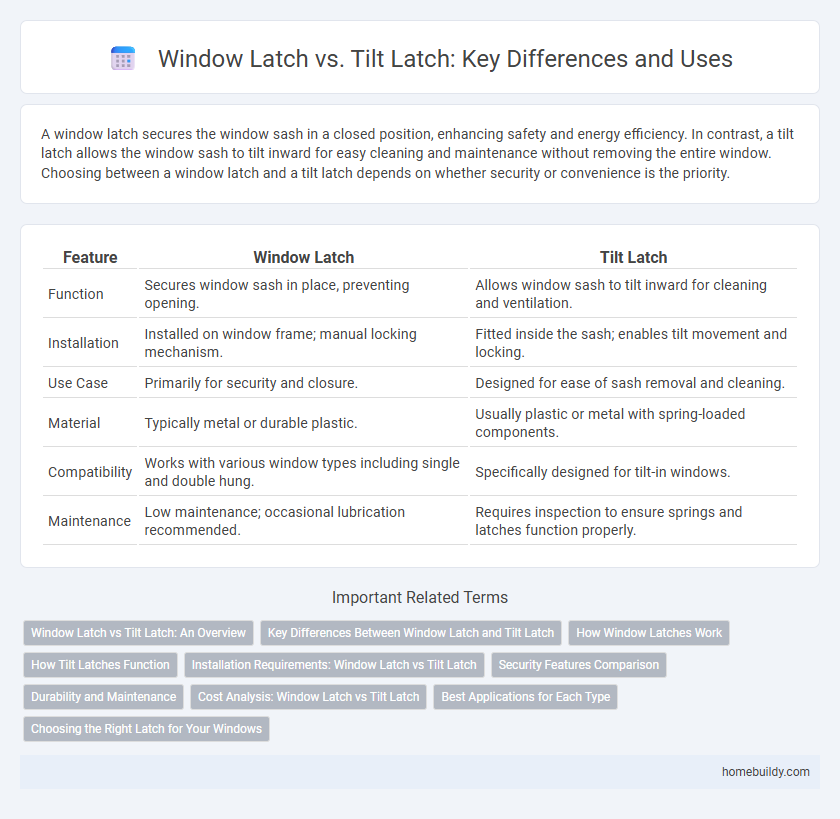A window latch secures the window sash in a closed position, enhancing safety and energy efficiency. In contrast, a tilt latch allows the window sash to tilt inward for easy cleaning and maintenance without removing the entire window. Choosing between a window latch and a tilt latch depends on whether security or convenience is the priority.
Table of Comparison
| Feature | Window Latch | Tilt Latch |
|---|---|---|
| Function | Secures window sash in place, preventing opening. | Allows window sash to tilt inward for cleaning and ventilation. |
| Installation | Installed on window frame; manual locking mechanism. | Fitted inside the sash; enables tilt movement and locking. |
| Use Case | Primarily for security and closure. | Designed for ease of sash removal and cleaning. |
| Material | Typically metal or durable plastic. | Usually plastic or metal with spring-loaded components. |
| Compatibility | Works with various window types including single and double hung. | Specifically designed for tilt-in windows. |
| Maintenance | Low maintenance; occasional lubrication recommended. | Requires inspection to ensure springs and latches function properly. |
Window Latch vs Tilt Latch: An Overview
Window latches secure traditional sash windows by locking the panes firmly in place, enhancing safety and insulation. Tilt latches are specifically designed for tilt-in windows, allowing easy removal and cleaning without uninstalling the window. Choosing between a window latch and a tilt latch depends on the window type and desired functionality for maintenance and security.
Key Differences Between Window Latch and Tilt Latch
Window latches secure the sash by locking the window frame, providing straightforward manual operation and enhanced security, while tilt latches enable the sash to tilt inward for easy cleaning and maintenance. Unlike window latches, tilt latches incorporate a release mechanism designed specifically for sliding the sash out of the frame, facilitating access without complete removal. The key difference lies in function: window latches focus on locking stability, whereas tilt latches prioritize accessibility with tilt-and-clean features.
How Window Latches Work
Window latches secure windows by engaging a locking mechanism that holds the sash firmly in place, preventing unwanted opening and enhancing safety. Unlike tilt latches, which allow the window sash to tilt inward for easy cleaning, window latches primarily focus on locking the window securely without enabling sash movement. This distinction highlights that window latches operate through a simple catch or hook mechanism designed for stability and security, while tilt latches incorporate additional features for mobility.
How Tilt Latches Function
Tilt latches are specialized window latches designed to allow the sash to tilt inward for easy cleaning and maintenance, providing greater accessibility compared to traditional window latches. These latches engage with the window frame through a spring-loaded mechanism, securely locking the sash in place while enabling quick release for tilting. Their functional design enhances both security and convenience by combining locking and tilting operations in one integrated hardware component.
Installation Requirements: Window Latch vs Tilt Latch
Window latches typically require straightforward installation involving basic tools, as they attach directly to the window frame for secure locking. Tilt latches demand precise alignment and additional steps, often necessitating the removal of the sash to properly fit the mechanism that allows tilting functionality. Proper installation of both types is crucial for ensuring safety, functionality, and window performance.
Security Features Comparison
Window latches offer robust security by firmly locking sashes in place, reducing the risk of forced entry through standard window frames. Tilt latches primarily facilitate easy pivoting for tilt-in windows, often sacrificing some security strength for convenience and ease of cleaning. When comparing security features, window latches generally provide a more secure locking mechanism due to their solid engagement and resistance to tampering.
Durability and Maintenance
Window latches typically offer superior durability due to their robust metal construction, which withstands frequent use and harsh weather conditions better than the often plastic or lightweight tilt latches. Maintenance for window latches is generally simpler, requiring occasional lubrication and minimal adjustments, whereas tilt latches may need more frequent inspection and replacement due to their complex mechanism. Choosing a window latch over a tilt latch can result in longer-lasting performance and reduced upkeep costs.
Cost Analysis: Window Latch vs Tilt Latch
Window latches typically cost between $5 and $15, offering an affordable and straightforward security solution for standard windows. Tilt latches, priced around $10 to $25, provide enhanced functionality by enabling easy window tilting for cleaning and ventilation, which justifies their higher cost. The choice between a window latch and a tilt latch depends on balancing budget constraints with desired operational convenience and security needs.
Best Applications for Each Type
Window latches provide secure locking primarily for traditional sash windows, making them ideal for applications requiring robust physical security and simple operation. Tilt latches are specifically designed for tilt windows, allowing easy tilting for cleaning and ventilation without compromising safety, making them best suited for modern or double-hung tilt window systems. Choosing the appropriate latch depends on window design compatibility and the desired balance between security and functionality.
Choosing the Right Latch for Your Windows
Selecting the right window latch depends on your window type and security needs; a traditional window latch offers straightforward locking for standard sash windows, while a tilt latch is specifically designed for tilt-in windows, providing easy removal and cleaning access. Tilt latches typically enable the sash to tilt inward for maintenance without fully unlocking, enhancing convenience and safety. Consider factors like window style, ease of operation, and security level when choosing between a window latch and a tilt latch.
window latch vs tilt latch Infographic

 homebuildy.com
homebuildy.com